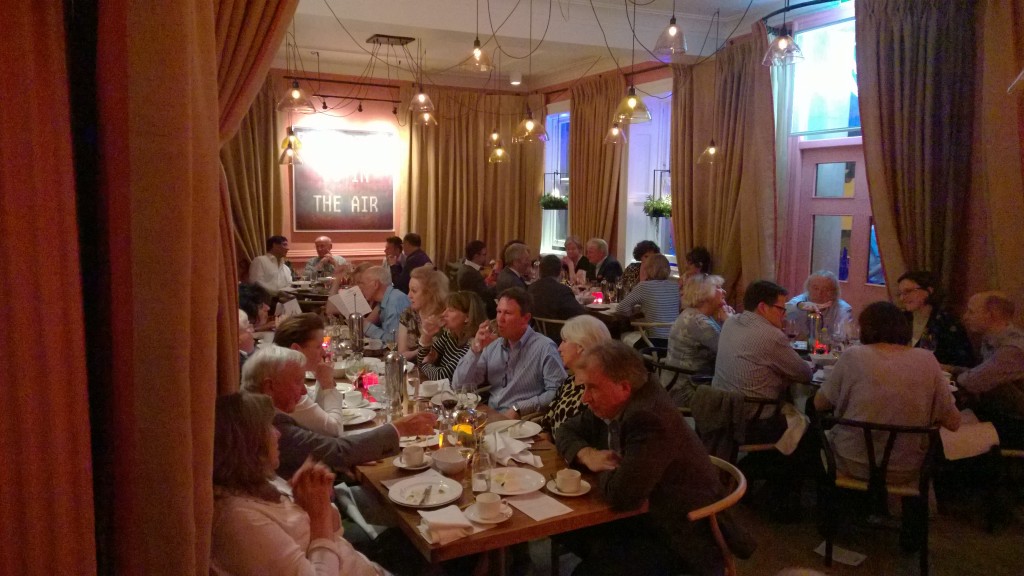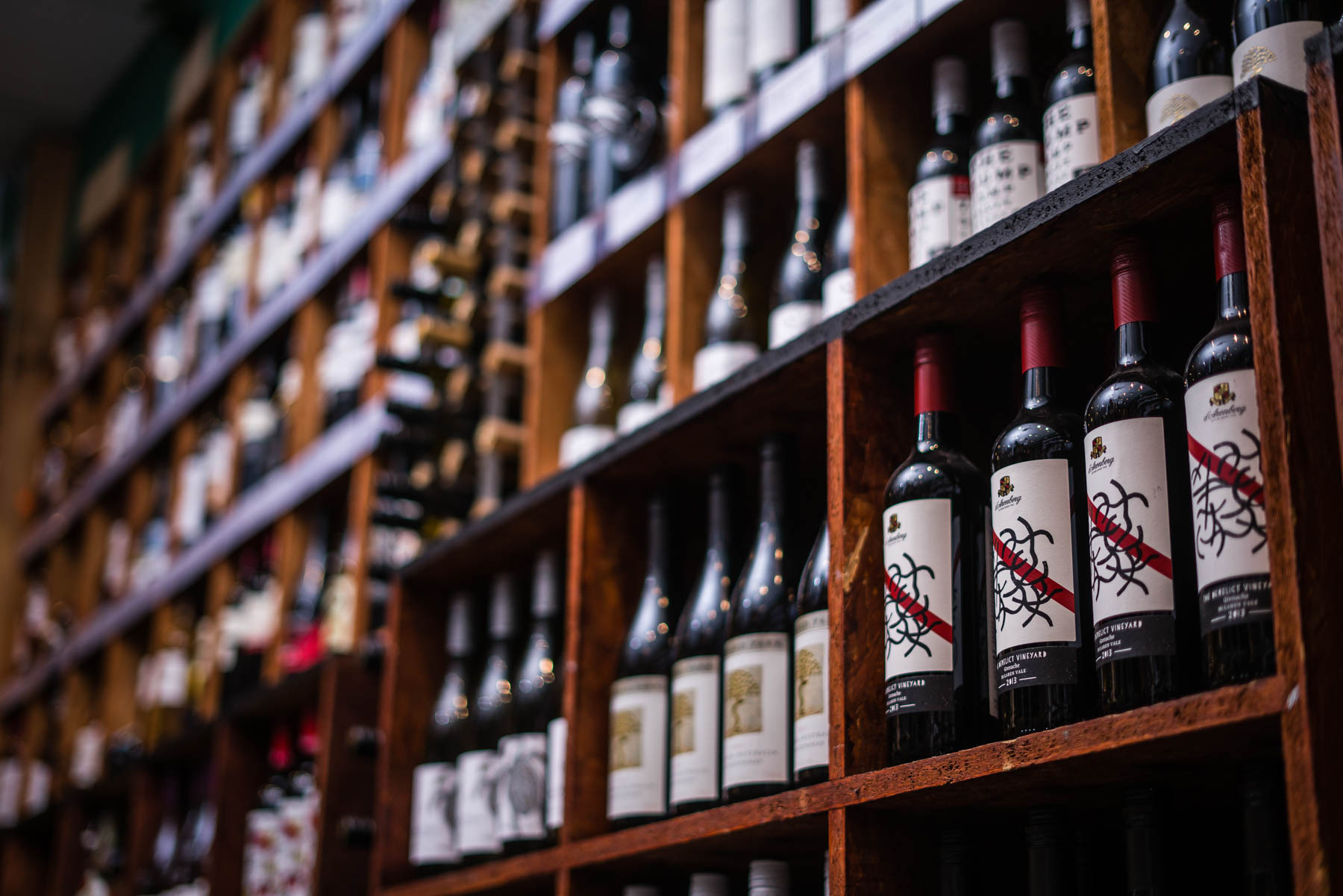Burgundy Dinner at Allium Brasserie
Laura on 22 Apr 2015
Last week Great Western Wine held their Burgundy dinner at the fabulous Allium Brasserie in the Abbey Hotel, Bath. GWW’s Fine Wine Manager Tom King and Allium’s Head Chef Chris Staines had devised a food and wine matching menu which showcased fresh, seasonal produce paired with a selection of white and red Burgundies. Master of Wine Jancis Robinson was also in town that night, but this didn’t stop over 60 people booking for the event – 20 more than rival Jancis!
 Tom’s knowledgeable, yet accessible, style chimed with the guests who had come to sample some of the world’s most sought after wines. Tom’s aim was to compare and contrast a snapshot of the region, proving that ‘terroir’ played its part in creating the unique flavours in the wine. He also highlighted the effect of vintage, ageing and climate on the style.
Tom’s knowledgeable, yet accessible, style chimed with the guests who had come to sample some of the world’s most sought after wines. Tom’s aim was to compare and contrast a snapshot of the region, proving that ‘terroir’ played its part in creating the unique flavours in the wine. He also highlighted the effect of vintage, ageing and climate on the style.
 The night began with a glass or two of Domaine Paquet Saint-Véran 2013 and some delicious nibbles, served in Abbey Hotel’s newly refurbished bar. Saint-Véran is an appellation next to the more famous Pouilly-Fuissé, sharing its soils and style. From further south than any other Burgundy at the tasting, Tom explained how its geographical location in the warmer Mâconnais gave the wine a more rounded, fruity style than the Chablis we were about to try with our meal.
The night began with a glass or two of Domaine Paquet Saint-Véran 2013 and some delicious nibbles, served in Abbey Hotel’s newly refurbished bar. Saint-Véran is an appellation next to the more famous Pouilly-Fuissé, sharing its soils and style. From further south than any other Burgundy at the tasting, Tom explained how its geographical location in the warmer Mâconnais gave the wine a more rounded, fruity style than the Chablis we were about to try with our meal.
As Tom pointed out, Burgundy is a big region, with the area of Chablis some 100km from Dijon, a city which marks start of the famous Côte-d'Or, home to the likes of Gevrey-Chambertin, Meursault and Montrachet: travel another 130km and you get to the Mâconnais in the south. With such a large region, and minute changes in soils and climate even within the vineyards themselves, Tom said that his purpose was not to cover every aspect of Burgundy as that would be impossible. Instead he would provide “little pictures of Burgundy” that we could see evolve as they interacted with food.
Our first wine and food match was Poached Cornish oysters with Watercress and Asian Pear paired with two different wines; a Chablis Premier Cru Montée de Tonnerre 2012 from Domaine Louis Michel and a Chassagne-Montrachet 2012 from Domaine Bernard Moreau.
Head Chef Chris Staines has a background in Michelin-starred fine dining, from heading up Foliage in London’s Mandarin Oriental hotel to working alongside Marco Pierre White at the three starred Oak Room. His attention to detail was evident in the first course – the finely chopped spiced pear bathed in a watercress velouté and punctuated with pearl-like oysters – but his love of Asian food also shone through with the hints of fresh ginger seasoning the dish.
 On its own, the Domaine Louis Michel Chablis Premier Cru Montée de Tonnerre 2012 was both richer and more minerally than the Saint-Véran. The style was also different than most Chablis you’d be used to – rather than the simple crisp, lemony, briny textures you’d expect, the premier cru was very complex with a salted honeycomb nose, hints of popcorn and touches of lemon and fennel. On further inspection, Tom suggested that you might also detect a whiff of brie rind and the flavours of white strawberry: It’s a wine which “punches above its weight”, he added.
On its own, the Domaine Louis Michel Chablis Premier Cru Montée de Tonnerre 2012 was both richer and more minerally than the Saint-Véran. The style was also different than most Chablis you’d be used to – rather than the simple crisp, lemony, briny textures you’d expect, the premier cru was very complex with a salted honeycomb nose, hints of popcorn and touches of lemon and fennel. On further inspection, Tom suggested that you might also detect a whiff of brie rind and the flavours of white strawberry: It’s a wine which “punches above its weight”, he added.
Chablis is a classic with oysters and some people say you can detect hints of oyster shell in the wine itself; the shells are certainly present in the soils of the area, once an ocean bed. The wine and the food tasted leaner and more minerally when paired together, bringing out the briny seaside flavours of the oyster.
 Over 100km away from Chablis, the Burgundies of Montrachet and beyond are richer and more full bodied, like Domaine Bernard Moreau Chassagne Montrachet 2012. This is a world away in style, with butter and orange notes on the nose with hints of caramel, almond and cooked lemon on the palate. The Chassagne might not have been the obvious choice with the oysters but the Japanese-style construction of the dish matched well with the wine’s richer flavours, heightening some tropical fruit nuances and hints of smoke. Although Tom preferred the leaner, saline qualities of the first match, the Chassagne was crowned the overall winner by the guests.
Over 100km away from Chablis, the Burgundies of Montrachet and beyond are richer and more full bodied, like Domaine Bernard Moreau Chassagne Montrachet 2012. This is a world away in style, with butter and orange notes on the nose with hints of caramel, almond and cooked lemon on the palate. The Chassagne might not have been the obvious choice with the oysters but the Japanese-style construction of the dish matched well with the wine’s richer flavours, heightening some tropical fruit nuances and hints of smoke. Although Tom preferred the leaner, saline qualities of the first match, the Chassagne was crowned the overall winner by the guests.
The second dish was Roast Breast of Landes Duck with Lettuce Purée, Fresh Garden Peas and Roasted Figs, paired again with two different wines, but this time from the same year and producer: Domaine Harmand Geoffroy’s Gevrey Chambertin En Jouise 2011 and Gevrey Chambertin 1er Cru Lavaux St Jacques 2011.
 Although Tom thinks that Burgundy is all “hints and suggestions” he said that the 2011 vintage has a distinct herbal, tobacco character. In terms of “suggestions”, Burgundy wine tasting notes often sound implausible for a drink made out of grapes – cheese, bacon, oyster shell and ladybird (?!) are all to be found.
Although Tom thinks that Burgundy is all “hints and suggestions” he said that the 2011 vintage has a distinct herbal, tobacco character. In terms of “suggestions”, Burgundy wine tasting notes often sound implausible for a drink made out of grapes – cheese, bacon, oyster shell and ladybird (?!) are all to be found.
It should come as no surprise then that the Gevrey Chambertin En Jouise had hints of smoky bacon, savoury almonds and cheese rind, as well as some of the more usual fragrances of vanilla spice, red cherry and green tobacco. I was amazed at the nutty aroma from the wine – like a fine Montgomery cheddar served with a dry Madeira.
 The Gevrey Chambertin 1er Cru Lavaux St Jacques was utterly different - more mineral in texture and aroma, with fine acidity – it seemed incredible that the wine was made by the same winemakers, in the same area, in the same year. Although I found the En Jouise more appealing at first, I soon realised that the more bashful Lavaux St Jacques was opening up, showing unbelievable levels of fragrance and refinement. Both wines had intensity, but the Lavaux had a finesse and florality that marked it as the premier cru.
The Gevrey Chambertin 1er Cru Lavaux St Jacques was utterly different - more mineral in texture and aroma, with fine acidity – it seemed incredible that the wine was made by the same winemakers, in the same area, in the same year. Although I found the En Jouise more appealing at first, I soon realised that the more bashful Lavaux St Jacques was opening up, showing unbelievable levels of fragrance and refinement. Both wines had intensity, but the Lavaux had a finesse and florality that marked it as the premier cru.
But, everything changed with the food – although the Lavaux St Jacques was the perfect match for the duck and sweet pea, the addition of the roasted fig challenged the wine a little too much. The En Jouise , a premier cru in everything but name, became deeply cherryish with hints of old dusty cupboards and earth, the concentrated, savoury sweetness of the fig transforming the pairing.
 Rather than a pudding (no sweet wines in Burgundy), Chris and Tom stuck to cheese for the last pairing of the night. Two Burgundian cheeses were presented with a white and a red, to see which wine went with which cheese. Tom pointed out that contrary to popular belief white wine is often best for matching with cheese. He explained that white wines have less structural components than reds so have a wider choice of partners.
Rather than a pudding (no sweet wines in Burgundy), Chris and Tom stuck to cheese for the last pairing of the night. Two Burgundian cheeses were presented with a white and a red, to see which wine went with which cheese. Tom pointed out that contrary to popular belief white wine is often best for matching with cheese. He explained that white wines have less structural components than reds so have a wider choice of partners.
The two Burgundies were from older vintages - Domaine Jobard-Morey Meursault Poruzot 1er Cru 2006 and Domaine Laurent Roumier Clos Vougeot Grand Cru 2003. The white Meursault came from a warm vintage and during its ageing process had developed complex flavours of saffron, iron ore, apricot and almond. At almost 9 years old, it was a great match for the truffley cheese, Brillat Savarin aux Truffes.
 The red Clos Vougeot Grand Cru was from a very hot year, 2003, and this made it less obvious that it was an older vintage. Tom thought its fruit profile was almost New Zealand in character; rich velvety and less ‘old world’ than you’d expect. The fruitiness was a nice foil for the funky, smelly Ami du Chambertin cheese – his time the cheesy whiff was from the cheese rather than the wine.
The red Clos Vougeot Grand Cru was from a very hot year, 2003, and this made it less obvious that it was an older vintage. Tom thought its fruit profile was almost New Zealand in character; rich velvety and less ‘old world’ than you’d expect. The fruitiness was a nice foil for the funky, smelly Ami du Chambertin cheese – his time the cheesy whiff was from the cheese rather than the wine.
This was a really enjoyable night, my first GWW event, and a very memorable one at that. The night was brilliant value too – the wine itself would have cost more that the price of the ticket, let alone the delicious food created by Chris Staines.
So, get yourself booked on one of GWW’s future events before they sell out – it’s a great way to learn about wine and lots of fun too.
By Chris Penwarden
Read the Crumbs Magazine review here

